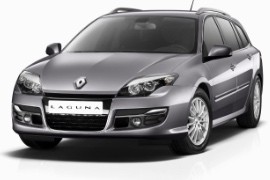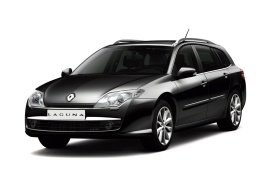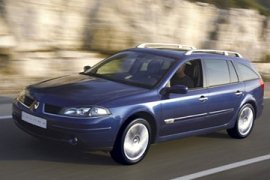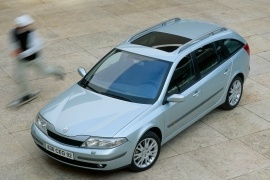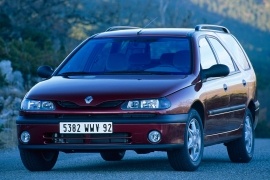RENAULT Laguna Estate Models/Series Timeline, Specifications & Photos
First production year: 1995
Engines: Diesel, Gasoline
Body style: Wagon (station wagon, estate, combi, touring)
Renault introduced a mid-life cycle impulse for its mid-size segment contender, the Laguna, in 2010 and added more style to the entire range, including the station wagon, which it named Estate.
In the aftermath of the world financial crisis, some carmakers survived, some didn't, and some were barely breathing. On the other hand, Renault was doing well enough, especially compared with its competitors, and tried to get more from a market that struggled to bounce back. It refreshed the Laguna and hoped for the best. Even though the station wagon market was not that important, it represented a significant part of Renault's profits, and the Laguna Estate was an important player.
At the front, the carmaker changed the bumper and gave the car an aggressive look, with a lower grille which looked like it was an extension for the upper grille, below the hood. Its headlights received a new treatment. On its sides, the carmaker redesigned the door mirrors to decrease wind noise. At the back, Renault upgraded the taillights' look with smoked lenses.
Inside, the carmaker improved the materials and the available options. Its dashboard received a new design with an integrated screen for the navigation system. The carmaker still insisted on keeping a separate stack for the audio controls behind the steering wheel. In the back, Renault installed a 60/40 split-folding bench which increased the trunk area when completely folded from 508 liters (17.9 cu-ft) to 1,593 (56.3 cu-ft).
Under the hood, Renault dropped the 1.6-liter naturally aspirated gasoline engine, which was a slow-seller anyway, and improved the rest of the range. Also, it added the 4Control all-wheel steering system, which decreased the car's turning radius to the level of a small-segment vehicle.
With a good range of engine choices, transmissions and trim levels, the 2007 Renault Laguna Estate (Station Wagon), was a good option on the market in its segment. It was a very good choice for the families, especially since the EuroNCAP ratings for the vehicle were on top of its class.
The design was modern, with angled headlights and Xenon offered as an option. The tire pressure monitor and the interior design were also good points gained by Renault in front of European customers. Its main rivals were the germans from Opel and Volkswagen.
There was a 2.0-liter gasoline engine, naturally aspirated or turbo, with three power levels: 140 hp, 170 hp and 205, respectively. When the car was launched, the diesel market in Europe was in full expansion. This is why the Laguna was offered with four turbodiesel variants ranging from a frugal 1.5-liter dci with 110 hp to a powerful 2.0-liter dci with 175 hp. The transmissions offered were either with a six-speed manual or a six-speed automatic for engines with over 150 hp.
The interior entertainment system was able to connect via Bluetooth, and even stream music from a mobile phone. A color-display navigation system was also available. Light-alloy-wheels were offered as standard on the upper trim levels, such as Dynamique, Expression, and Initiale.
Renault introduced the second generation of the Laguna in 2005 and was the safest car in its class, and it was built in two body versions: hatchback and station wagon.
The French carmaker had its hands full. After just two years since it completely refreshed its compact segment vehicles, it moved to the upper level, the Laguna. It wasn't the most expensive nor the most luxurious car in its stable, but it tried to be the best choice for the middle class, fighting hard against Ford Mondeo, Volkswagen Passat, or Opel/Vauxhall Vectra.
While other carmakers proved that sedan bodyworks were doing better than the hatchbacks, Renault offered the Laguna II only as a hatchback or a station wagon. Its angular-shaped headlights were narrow and continued by a black grille with the rhomboidal badge placed on a distinct, body-colored vertical slat in the middle. The designers created a rounded shape grille at the bottom, flanked by round fog lights on the outer side. From its profile, it featured an extended, arched roofline. Its curved and sloped-down tailgate created a sporty image for the station wagon.
Inside, it shared the same interior with its hatchback brother. Depending on the trim level and options, it featured a two-tone, curved dash panel covered in a soft material for an up-market feeling. In the top-trim level, Initiale, it sported wood trims on the steering wheel, gear-stick, and on the front of the dashboard. For vehicles fitted with a navigation system, the screen was above the center stack. In the back, the carmaker installed a 60/40 split-folding bench, which could expand the trunk from 475 liters (16.8 cu-ft) to 1,500 liters (52.9 cu-ft).
Under the hood, Renault installed a choice of five gasoline and seven turbo-diesel engines, depending on the market. A four-speed automatic transmission was available as an option for selected powerplants.
Renault replaced the Laguna lineup in December 2000, after seven years of presence for the nameplate's first generation, and the new vehicle was larger and packed with more technology and amenities.
Sharing its platform with the Nissan Primera was an excellent idea since that led to lower development costs and, in addition, a longer wheelbase which resulted in a roomier cabin. Moreover, the carmaker managed to create a better-designed station wagon, with a shape that didn't resemble a utility vehicle but a look that was closer to a hatchback.
Its exterior showed a sharp look with clear-cut headlights and a trapezoidal grille adorned on its upper side by a trim on the hood. That was an unusual detail for a car, but Renault did it anyway, and it kind of looked good. The Laguna Estate's profile revealed an arched upper window line curved down towards the D-pillar. Finally, at the back, the raked-forward, curved shape of the tailgate was flanked on the lower sides by corner-mounted taillights.
Inside, the gizmo territory started to fade away. Apart from the push-button start and the card to access the vehicle, there were not too many out-of-the-box features. The interior room was ok for its size, especially the headroom for the rear passengers. In addition, the folding seatback of the rear bench made the car more spacious if some would need the car to be used by a salesperson.
The 2000 Laguna was equipped with diesel and gasoline engines, mated as standard with a 5-speed gearbox. In addition, there was an option for a 5-speed automatic gearbox, but only for the top, V6-engine version. The Laguna II was the first car to receive a 5-Star rating at the EuroNCAP crash tests.
RENAULT Laguna Estate 1.6L 16V 5MT FWD (110 HP)
RENAULT Laguna Estate 1.8L 16V 5MT FWD (123 HP)
RENAULT Laguna Estate 1.9L dCi 5MT FWD (100 HP)
RENAULT Laguna Estate 2.0L 16V 5AT FWD (135 HP)
RENAULT Laguna Estate 2.0L 16V 5MT FWD (140 HP)
Renault refreshed its mid-size vehicle range, Laguna, in 1998, four years after it introduced the model on the market.
When the French carmaker decided to change its naming system and went from numbers to names, the Laguna was the one that replaced the 21 lineup. But it wasn't just a tiny detail; it was more like a revolution. When the customers started to understand the change, Renault brought a refreshed lineup for both body shapes: the hatchback and the station wagon.
Renault received numerous complaints about the 1994 Laguna's headlights, which suffered from some quality issues, which was why it decided to change them. The new model featured clear-lens headlamps and darkened background. But it kept the same bird-beak design for the grille, with a lowered center area for the hood bent downwards towards the bumper. A new set of round foglights replaced the previously used squared ones with rounded exterior shapes. The carmaker changed the black plastic moldings around the bumper and tailgate at the back, creating a continuous line from side to side.
But the most important upgrades were under the hood, where the carmaker introduced new or redesigned engines. The carmaker installed a new, 1.6-liter unit on the base model, keeping a low starting price for the Laguna. Another important improvement was for the turbo-diesel lineup, which received two direct-injected powerplants that provided 100 hp and 110 hp, respectively. In Italy, Portugal, and Greece, the vehicles with over two-liter displacement were heavily taxed. With the new oil-burners, which were highly fuel-efficient, the carmaker increased its market share.
When Renault decided to change the nameplates from numbers to names, the 21 was replaced by the Laguna, which marked a new beginning for the French brand's mid-size vehicle.
Unlike its predecessor, which was offered in three body shapes, the Laguna was available only as a hatchback and a station wagon named Estate. The 21 was designed at the beginning of the '80s, and its wedge shape was already obsolete. Its technology was also outdated, so the carmaker started from scratch with the new model.
Patrick LeQuement was the chief designer for Renault, and he imagined the Laguna in the bio-design trend, which customers still appreciated. He made the Laguna Estate for families with children, who needed a big trunk in the back for bicycles and luggage for long travels. The raked-forward C-pillar was a design cue opposed to the German styling, which favored the vertical pillars (such as those from the Opel Vectra and Ford Mondeo). Its big tailgate was flanked on the sides by vertical taillights, mounted few inches above the rear bumper to keep them protected from small bumps in the parking lots.
Inside, the car looked modern for those times. Its instrument cluster was rounded and featured a center-mounted speedometer, flanked by the tachometer on the left and the fuel and temperature gauges on the right. Like Toyota, Renault chose to place the climate control dials above the radio cassette player. The front bucket seats offered little bolstering, while in the back, the carmaker opted for a split-folding rear bench. That expanded the trunk size from 520 liters (18.4 cu-ft) up to 1,782 liters (63 cu-ft).
Under the hood, Renault installed a choice of five engines ranged between 95 hp and 140 hp.
